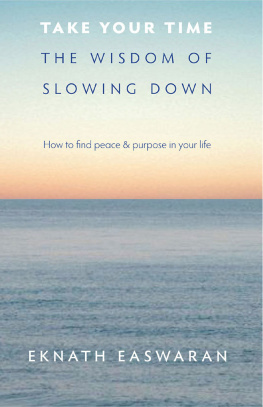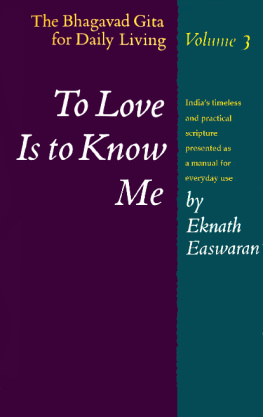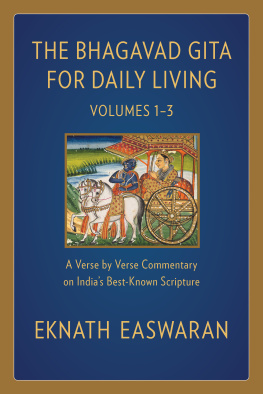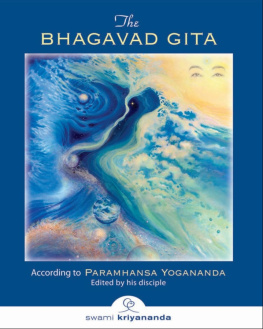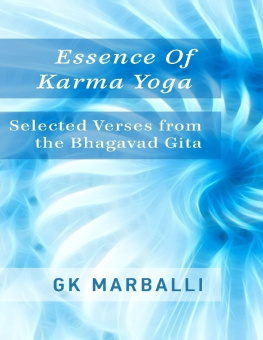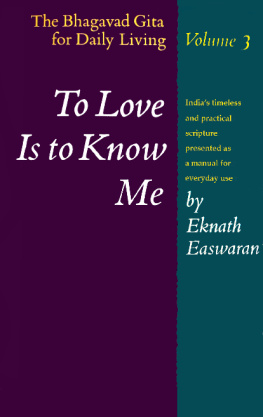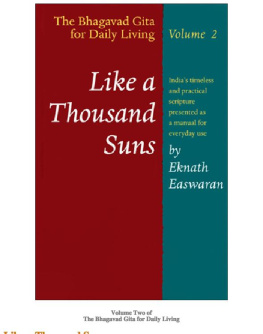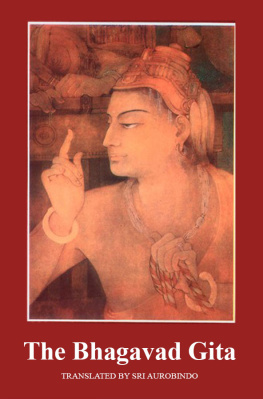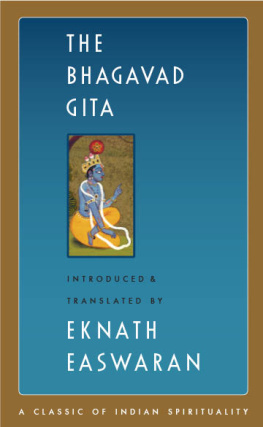Chapter 1
The War Within
We open the Gita and are plunged into the confusion of war. Armies are about to clash, and the air echoes with the blare of conch horns and the trumpeting of elephants in full armor pandemonium that surely belongs more to the Iliad or even a war movie than to a scripture on yoga.
Yet this drama is essentially stage-setting a bridge to the real beginning of the Bhagavad Gita in chapter 2, when Sri Krishna begins to teach. Then we find ourselves in a different world, serene and detached, where verse after verse reveals that the battle referred to is one that takes place within: the struggle between right and wrong, selfishness and selflessness, anger and compassion, that rages continuously in every human heart. The chaos of the opening chapter only mirrors the turmoil we feel within.
Each of us can recognize Arjunas crisis here, caught as he is between opposing forces in a struggle beyond his control. With reason and duty pleading for both sides, he is pulled in two, so unsure of what is right that he cannot act:
ARJUNA:
O Krishna, I see my own relations here anxious to fight, and my limbs grow weak; my mouth is dry, my body shakes, and my hair is standing on end. My skin burns, and the bow Gandiva has slipped from my hand. I am unable to stand; my mind seems to be whirling. These signs bode evil for us....
SANJAYA:
Overwhelmed by sorrow, Arjuna spoke these words. Casting away his bow and his arrows, he sat down in his chariot in the middle of the battlefield. (1:2831, 47)
Much of this struggle is hidden from our conscious awareness. We may glimpse it in dreams or therapy sessions, but we have learned to close our eyes and pretend it does not exist. We see only its consequences, the painful wastage of conflict and indecision that litters our days: the skirmishes of daily life, quarrels at home and work, angry outbursts at those we love, absurd tensions that we can neither explain nor set aside. Turbulent thoughts urge us in opposing directions, undermining the will, leaving us doubtful and confused about what to do. This may not be Ypres or Stalingrad, but the fight is epic enough and, like the Hundred Years War, it can last a lifetime.
All the confusion in our daily lives, the Gita teaches, arises from this turmoil in the mind. Uncertain about what to do, we end up fighting on both sides. We are fighting ourselves, and the conflict lays waste our strength.
And the turmoil is contagious. Anger and suspicion spread. All conflicts in the world outside us, the Gita would say not just our own small battles, but those that divide communities and even nations are the sum total of the internal conflicts raging around the globe. The wars, persecutions, and violence that fuel the morning news do not erupt out of nowhere, but depend on ordinary people fanning the flames of hatred, fear, and anger. As the Buddha puts it, everyone is on fire, and little is required for us to fan each other into a blaze. At home and work, just one person getting angry can set fire to everyone around; while on the international level, the world has seen far too many instances where people who have lived together for generations suddenly break out in savage violence or civil war.
Higher & Lower Self
Underlying this confusion, the Gita would say, is a kind of schizophrenia. We dont know who we are. We dont know what we are as human beings, so we are divided against ourselves. On the one hand, we behave like separate creatures engaged in a struggle for survival with the rest of life. Yet at some deep level, we also know that this image of ourselves is inaccurate: that we are not separate from nature but part of a much larger whole, motivated not merely by personal survival but even more by love, ideals, beauty, a sense of right and wrong values that cant be denied without losing something of our humanity.
That is why Arjunas plea for help at the outset of the Gita so immediate, so personal, so urgent is met by a reply that is lofty, universal, and timeless:
SRI KRISHNA:
You speak sincerely, but your sorrow has no cause. The wise grieve neither for the living nor for the dead. There has never been a time when you and I and the kings gathered here have not existed, nor will there be a time when we will cease to exist.... The impermanent has no reality; reality lies in the eternal. Those who have seen the boundary between these two have attained the end of all knowledge. Realize that which pervades the universe and is indestructible; no power can affect this unchanging, imperishable reality. The body is mortal, but that which dwells in the body is immortal and immeasurable.... You were never born; you will never die. You have never changed; you can never change. Unborn, eternal, immutable, immemorial, you do not die when the body dies. (2:1112, 1620)
Under the circumstances, this reply sounds hopelessly philosophical. Arjuna is in a crisis that is about to explode, with disastrous consequences; he wants to know what to do. We may feel similarly impatient facing our own crises. Yet instead of hacking at branches, the Gita is going to the root. If we dont know who we are, we cant know what we want and will go on seeking things that cant satisfy us, ultimately at the expense of anyone who gets in the way. At first this leads merely to frustration, but frustration leads to anger and anger can build up to war. Only by understanding who we are and what can truly satisfy us can we find a basis for living together in peace and prosperity.
The Gita presents this dilemma as a conflict between a lower self and a higher one. The Sanskrit word for what makes us identify with this lower, separate self is ahamkara literally, I-maker, the component of personality that presents us to ourselves as isolated from the rest of life. Calling this self lower simply reflects the fact that it is so limited just the slimmest fraction of what we are as human beings. Compared with what we really are, the Gita says, this lesser self is a cage of separateness, and identifying ourselves with it is the source of insecurity, friction, disrupted relationships, and mounting dissatisfaction.
In practical terms, as long as there is division in consciousness, there will be separateness simply because this is how we see: People are other than me; its me against the world. And as long as there is separateness, there will always be a tendency to exploit and manipulate others to make up for what we feel we lack.
We can envision this division in consciousness as a wound that never heals. In a few people this wound is only skin-deep: the sense of separateness is slight, so they are secure and do not depend on anything outside themselves; they are sensitive to the needs of others without needing to lean on anyone. But most of us suffer from a cut in consciousness that goes to the bone; and the deeper the cut, the greater the insecurity that comes from feeling isolated from the rest of life and even from oneself. From this insecurity comes conflict and all the other negative emotions and behavior that arise from feeling alienated and alone: frustration, depression, loneliness, jealousy, suspicion, resentment, acquisitiveness, anger. Worst, each of these effects becomes a cause; they interconnect and feed each other, as chaotic as the weather, building to a storm.
In other words, this split in consciousness conditions how we see life. So long as we see through the conditioning of separateness, life seems fragments of a puzzle that do not fit together, without even a picture on the box.
How shall we characterize this split? It has been called a tug of war between the selfish and the selfless in us, a tension between a higher self and a lower one, a struggle between wisdom and ignorance of our real nature. More positively, we can think of it as the tension of an evolutionary drive towards the full realization of our human potential. According to the Gita, in every one of us by virtue of our being human there is an upward surge to evolve, to grow in humanity day by day, and a downward pull to remain engaged in conflict as separate creatures set against the rest of life. In this view, the human being is still in the making, evolving from an animal past towards a much greater freedom. The war within is between the inertia of our biological heritage and this irrepressible drive to fulfill what is latent in our nature.


